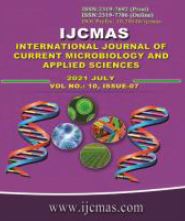


 National Academy of Agricultural Sciences (NAAS)
National Academy of Agricultural Sciences (NAAS)

|
PRINT ISSN : 2319-7692
Online ISSN : 2319-7706 Issues : 12 per year Publisher : Excellent Publishers Email : editorijcmas@gmail.com / submit@ijcmas.com Editor-in-chief: Dr.M.Prakash Index Copernicus ICV 2018: 95.39 NAAS RATING 2020: 5.38 |
Present study was designed to evaluate and investigate the cadiotoxicity induced through oral feeding of acrylamide (ACR) and its amelioration strategies using different antioxidants in Wistar rat model. A total number of 32 adult male Wistar rats were divided into eight groups (G1-G8) G1, (Basal Diet only), G2 (α-tocopherol+basal diet), G3 (GSH), G4 (Corn oil), G5 (ACR),G6 (ACR+ α-tocopherol G7 (ACR + GSH) and G8 (ACR + α-tocopherol+ GSH). ACR, α-tocopherol and GSH were orally administered to rats @ 30 mg/KgBW, 5 IU/ KgBW and 2mg/ KgBW, respectively for 45 days. The study revealed significant reduction in body and heart weights in ACR fed rats (G5) compared to control rats (G1-G4) whereas, the weight were significantly restored in (G6-8). Heart tissues were collected after 45th day for the assessment of morphological, biochemical, histopathological and oxidative stress parameters. ACR intoxication resulted in oxidative stress as evident from higher levels of MDA and lower activities of antioxidative enzymes SOD, GSH, GST and CAT in rats (G5) compared to (G1-4). These parameters showed significant (P<0.05) restoration in (G6). Serum biochemical parameters were restored in G6 and G7 compared to G5.Histopathologically, the heart tissues revealed severe degeneration, necrosis and separation of cardiac muscle fibers with extravassation of RBCs in (G5) while it was restored and marked improvement was visible in ameliorating groups (G6-G8) in comparison to (G5). With the end of the study in conclusion it was evident that α-tocopherol and GSH played substantial role in maintaining the balance between oxidant and antioxidant mechanisms and in specific, α-tocopherol conferred better protection from ACR induced cardiotoxicity.
 |
 |
 |
 |
 |